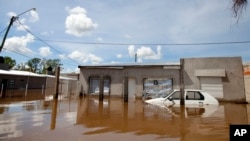Massive, widespread flooding forced tens of thousands of people in South America to take refuge in shelters on Monday, as they endured heat, bugs and dirty running water because of contaminated sewer lines.
The floods were caused by heavy rains and bulging rivers over the last several days and come at the beginning of the Southern Hemisphere's summer months. That means evacuees were also dealing with heat, humidity, mosquitoes and snakes that thrive in swamp-like conditions.
Concordia, about 264 miles (425 kilometers) north of Buenos Aires, was among places that were particularly hard hit. Some houses had water nearly up to the roofs, and people made their way around town in canoes.
"The water [from sinks] is contaminated and bugs are everywhere,'' said Josefina Monson, a 33-year-old who has been in the shelter with her husband and young daughters since Christmas Eve. "I'm not sure when we'll be able to go home.''
It was unclear what thousands of people will find when they do return to their homes after the waters subside. At least 20,000 have been evacuated in Argentina. Neighboring Paraguay has been hardest hit, with 144,000 evacuated, mostly in areas bordering the Paraguay River. Several thousand have also been evacuated in Uruguay and southern Brazil.
The floods have been responsible for at least eight deaths: six in Paraguay and two in Uruguay. Causes of death have ranged from falling trees to electrocution.
Over the weekend, both Argentine President Mauricio Macri and Brazilian President Dilma Rousseff toured affected areas and announced measures to help people recover and rebuild their homes.
Meteorologists attribute the heavy rains to the El Nino weather phenomenon, which happens every few years when the Pacific Ocean warms up around the equator. While rains had subsided in many areas by Monday afternoon, more rain was expected over the next couple days.
In Buenos Aires on Monday, Vice President Gabriela Michetti called a meeting of several top officials to coordinate recovery efforts. Many criticized the previous government's response to heavy flooding in the Buenos Aires province in August, which also forced tens of thousands to evacuate and became a flashpoint ahead of presidential elections.
"I can only get within two blocks of my house,'' said Alejandra Peritas, a 43-year-old in Concordia who took her two children to a shelter. "I can only see the roof. The rest is covered in water.''







